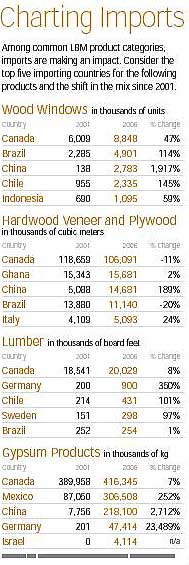Impact on Dealers
The impact of shifting or simply importing materials is minimal, if almost invisible, to dealers, even when small-volume shops sell direct to contractors–assuming importers pay close attention to details and quality to either meet or exceed a dealer’s expectations for quality, price, and availability. “It has changed the way we do business, especially monitoring the [overseas] supply chain from start to finish,” in order to control the process and protect BMD’s reputation as a reliable LBM distributor, says Tabor. “It’s not easy or inexpensive, but it’s necessary.”
The two corporate divisions at BMD that import building materials include in-house associates dedicated and trained to maintain direct relationships with the company’s overseas suppliers. “Our ability to audit quality control [at an overseas manufacturing plant] is robust,” says Tabor. “We trust our processes.”
Both Wilcoxson and Damalas also understand and respect that condition. To avoid potential conflicts of interest that might let manufacturing quality slide, Home Central Imports pays a China-based partner as a profit participant versus on salary. “Everything that goes into the supply chain is a struggle, especially from this far away,” says Wilcoxson, adding that Chinese business culture and language issues also create hurdles to success. “Even if they were next door, it would still be difficult.”
Damalas, meanwhile, maintains a direct relationship with his suppliers. “It’s too critical not to,” he says of his three-week visits every quarter. “I can’t leave it to others to match our priorities and expectations” for quality, lead time, and other supply chain logistics.
Dealers (and their pro and retail customers) are also blinded to the more traditional importing process in which domestic manufacturers bring in raw or semi-finished goods from overseas, improve or remanufacture them, and sell them as American-made. For instance, it’s common for coiled sheet metal to come across from China and get bent into framing connectors; the benefit being the ability to keep the retail price competitive. “There isn’t a company in the U.S. that wouldn’t prefer to keep everything in the States,” says Tabor, “but they can’t find the labor to do it” and still sell their products at the same price as what importing affords.
For value-added products now being imported in greater volume and regularity and into more domestic markets, dealers have not found a niche similar to stocking commodity imports. Though United Pacific Imports still sells direct to builders and contractors, primarily to maintain healthy margins, Damalas has yet to be approached by, or approach, dealers to siphon off his supply line. “I’ve had a few builders interested in integrating vertically [with the product],” he says, but no dealers or distributors.
More commonly, Damalas has been targeted by importers of other building products to provide logistical support, specifically a last-mile, just-in-time warehousing and jobsite delivery service that he initiated with multifamily contractors buying small bulk quantities of his imported cabinets.
Chinese manufacturers and distributors, meanwhile, have targeted Home Central Imports to carry their value-added products, such as flooring, as a way to establish brands in the U.S. That’s a potential opportunity for dealers to get in on the import action. “I can see a lot of [domestic] companies lining up with them,” says Wilcoxson. “They want their own brand now rather than just being [original equipment manufacturers].”
Wilcoxson also faces a crossroads of whether to maintain his custom-order business model for delivering cabinets from China or invest in a showroom and boost volume to possibly attract dealers as well as more contractor customers. A year into his venture, he’s leaning toward the former. “I could have 5,000 cabinets in a showroom and still not have what a customer wants,” he says, thereby risking overhead overload. “For a few hundred dollars, I can bring in samples to demonstrate the quality and let them order exactly what they want.”
In today’s world of increasing customer choice, especially among high-end builders and their home buyers with regards to finish products–even more so if the price is right–perceptions about overseas products are quickly being dashed. “The biggest stumbling blocks for customers are quality and lead time, and we feel we have those issues solved,” says Wilcoxson. “All we ask is that they give China a look.” It’s a request that the entire supply chain is likely to hear more often, and about several foreign countries and a variety of categories, sooner than later.
–Rich Binsacca is a contributing editor for ProSales.



